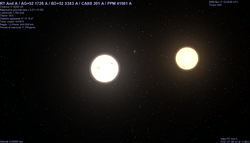RT Andromedae
RT Andromedae is a variable star in the constellation of Andromeda. The system is estimated to be 322 light-years (98.7 parsecs) away.[3]
 RT Andromedae system. | |
| Observation data Epoch J2000.0 Equinox J2000.0 | |
|---|---|
| Constellation | Andromeda |
| Right ascension | 23h 11m 10.099s[1] |
| Declination | +53° 01′ 33.04″[1] |
| Apparent magnitude (V) | 9.043[2] |
| Characteristics | |
| Spectral type | F8-G0V + K1-3V [3] |
| Variable type | RS CVn |
| Astrometry | |
| Radial velocity (Rv) | 0.60±0.6[4] km/s |
| Proper motion (μ) | RA: -7.01[1] mas/yr Dec.: -20.80[1] mas/yr |
| Parallax (π) | 10.1267 ± 0.0424[5] mas |
| Distance | 322 ± 1 ly (98.7 ± 0.4 pc) |
| Absolute bolometric magnitude (Mbol) | 5.707 / 4.079[6] |
| Orbit[7][6] | |
| Period (P) | 0.62893095 ± 0.00000009 d |
| Semi-major axis (a) | 0.01787 AU (3.839 R☉) |
| Eccentricity (e) | 0.0049 ± 0.0005 |
| Inclination (i) | 87.26 ± 0.07° |
| Periastron epoch (T) | JD 2436697.857 |
| Details[6] | |
| RT And A | |
| Mass | 1.088 ± 0.030 M☉ |
| Radius | 1.286 ± 0.011 R☉ |
| Temperature | 6,150 ± 132 K |
| RT And B | |
| Mass | 0.837 ± 0.030 M☉ |
| Radius | 0.956 ± 0.012 R☉ |
| Temperature | 4,780 K |
| Other designations | |
| Database references | |
| SIMBAD | data |
RT Andromedae is classified as a RS Canum Venaticorum variable, a type of close eclipsing binary star. It varies from an apparent visual magnitude of 9.83 at minimum brightness to a magnitude of 8.97 at maximum brightness, with a period of 0.6289216 days.[8] The system consists of a G-type main-sequence star slightly more massive than the Sun, and a K-type main-sequence star slightly less massive; the light curve of this eclipsing binary exhibits secular variations of period and minima.[3]
Presence of a third body
According to Pribulla et al. (2000), the changes in variability could be ascribed to a third object in the system, with even a possible fourth. Its minimum mass is estimated to be 5 percent the mass of the Sun (roughly 50 times the mass of Jupiter), with an orbital period close to 75 years and an eccentricity that is thought to be fairly high (at 0.56).[3] Such an object could likely turn out to be a brown dwarf or even a massive jovian planet. However, a recent paper of Manzoori (2009) noticed that there is a decreasing trend in the orbital period, so magnetic braking could explain better the evolution of this orbital system.[6]
References
- van Leeuwen, F. (2007). "Validation of the new Hipparcos reduction". Astronomy and Astrophysics. 474 (2): 653–664. arXiv:0708.1752. Bibcode:2007A&A...474..653V. doi:10.1051/0004-6361:20078357. Vizier catalog entry
- Høg, E.; et al. (2000). "The Tycho-2 catalogue of the 2.5 million brightest stars". Astronomy and Astrophysics. 355: L27–L30. Bibcode:2000A&A...355L..27H.
- Pribulla; et al. (2000). "Active eclipsing binary RT Andromedae revisited". Astronomy & Astrophysics. 362: 169–188. Bibcode:2000A&A...362..169P.
- Karataș, Y.; Bilir, S.; Eker, Z.; Demircan, O. (April 2004). "Kinematics of chromospherically active binaries and evidence of an orbital period decrease in binary evolution". Monthly Notices of the Royal Astronomical Society. 349 (3): 1069–1092. arXiv:astro-ph/0404219. Bibcode:2004MNRAS.349.1069K. doi:10.1111/j.1365-2966.2004.07588.x.
- Brown, A. G. A.; et al. (Gaia collaboration) (August 2018). "Gaia Data Release 2: Summary of the contents and survey properties". Astronomy & Astrophysics. 616. A1. arXiv:1804.09365. Bibcode:2018A&A...616A...1G. doi:10.1051/0004-6361/201833051.
- Manzoori, D. (2009). "Cyclic Variations of Orbital Period and Long-Term Luminosity in Close Binary RT Andromedae". The Astronomical Journal. 138 (6): 1917–1924. Bibcode:2009AJ....138.1917M. doi:10.1088/0004-6256/138/6/1917.
- Erdem, A.; Demircan, O.; Güre, M. (2001). "The light and period changes of RT Andromedae". Astronomy & Astrophysics. 379 (3): 878. Bibcode:2001A&A...379..878E. doi:10.1051/0004-6361:20011357.
- RT And, database entry, Combined General Catalog of Variable Stars (GCVS4.2, 2004 Ed.), N. N. Samus, O. V. Durlevich, et al., CDS ID II/250 Accessed on line 2009-06-22.